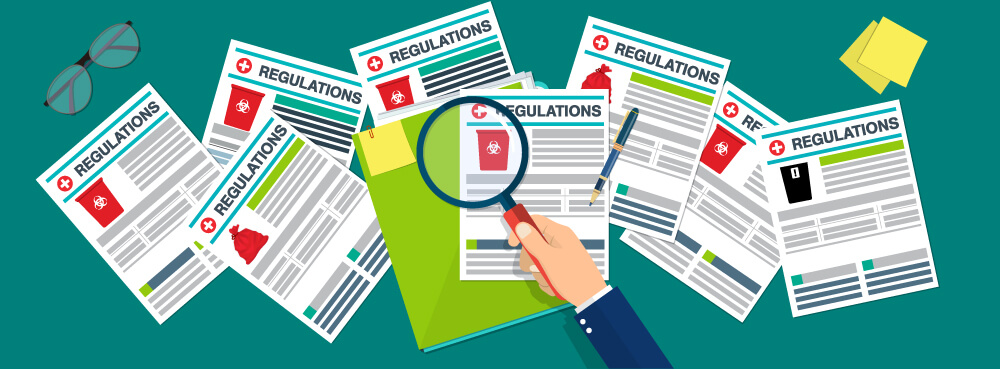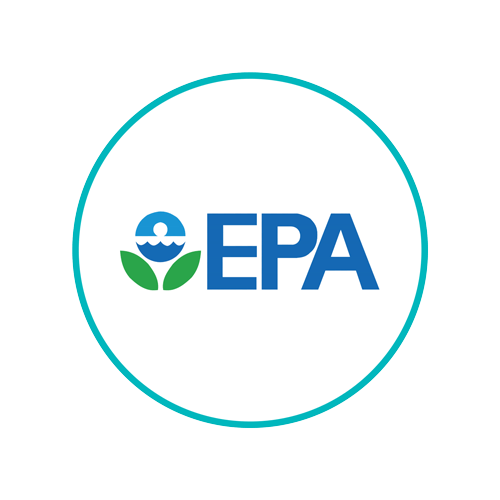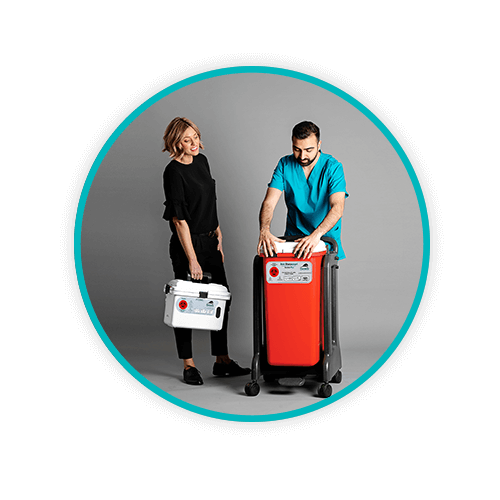How to Keep Track of Changing Regulations

It can be both vexing and time-consuming to ensure that local, state, and federal regulations are being followed for biomedical and hazardous waste management processes. Any company or facility that produces regulated waste of any kind needs to know how to properly segregate and dispose of it, but where do you start? Where do you look for the most up-to-date resources for seemingly ever-changing laws and regulations?
You might think that following your own states guidelines is adequate when it comes to biomedical and hazardous waste management and disposal, but you must also follow federal guidelines.
It’s your job to know all the regulations in order to maintain compliance and avoid massive fines and penalties that can not only damage reputation, but possibly even sink your business. So, how do you keep track?
TOPICS WE WILL COVER:
2 / Finding Federal Regulations
3 / State Administrative Codes
4 / State Departments of Environmental Quality or Natural Resources
Where to start
Starting a search for specific regulations for biomedical or hazardous waste generators is daunting for many. You don’t have to be a hospital to generate potentially hazardous, biomedical, or otherwise regulated waste. You can be a dental facility, a tattoo or body-piercing parlor, a veterinary practice, or a cancer or dialysis treatment center, among a long list of examples.
Not only can state or federal rules be hundreds of pages long and cover a multitude of details, but it can often require a lot of back and forth between federal and state regulatory bodies to find the most up-to-date guidelines.
Having a specific topic in mind, such as how to dispose of regulated medical waste, sharps waste, infectious veterinary waste, or even dental amalgam waste is helpful, but still often requires diligence in digging through regulatory content.
For this reason, it is recommended that specific topics be broken down into categories. For example, are you dealing with regulated medical waste or hazardous waste? Do you know the difference? Do you know how hazardous waste is classified or are you simply dealing with a non-hazardous biomedical waste? These are important questions to help guide your search. When it comes down to it, do you know how the federal government as well as your state defines hazardous and non-hazardous waste streams?
Bottom line: You need to keep track of local (county level), state and federal guidelines to ensure that you’re following the laws and avoid issues of non-compliance. It doesn’t really matter where you start, as long as you cover all the bases.
Finding Federal regulations
When it comes to federal regulations for regulated, solid, or hazardous waste management, turn to the Environmental Protection Agency’s Resource Conservation and Recovery Act (RCRA). The agency covers a wealth of regulations for non-hazardous waste and hazardous waste streams. They also provide information regarding policies and guidance documents, as well as a plethora of rules and checklists that are consistently updated.
When it comes to pharmaceutical waste, the Environmental Protection Agency (EPA) also provides clear guidelines for hazardous waste pharmaceuticals and numerous guidance documents, including reporting requirements.
The primary document from which the majority of federal and state guidelines originate is Title 40 of the Code of Federal Regulations (Title 40 CFR). This massive legal document is divided into chapters and subchapters. For example, guidelines for the storage and collection of residential, commercial, and institutional solid waste can be found under Title 40, Chapter 1, Subchapter 1, Part 243.
Information about the Hazardous Waste Management System can be found under Part 260 of this subchapter, while identification and listing of hazardous waste can be found under Part 261. Standards applicable to generators of hazardous waste can be found under Part 262.
It’s recommended that you review the Definitions and Table of Contents first to make searches easier.
Definitions are important. When defining or trying to identify or classify the type of waste your business or facility generates, start at the state level and determine how your state defines terms such as biological waste, biohazardous waste, hazardous waste, and so forth. They are not all the same. At times, the state’s definitions can be slightly different than those of the federal government.
State Administrative Codes
In most cases, definitions are found in a state’s administrative codes or state regulations. For example, simply type in your state followed by “administrative codes” and you’ll be directed to appropriate sources that breakdown departments and topics with linkable access. For example, the Administration Code for Wisconsin can be found here.
State Departments of Environmental Quality or Natural Resources
Every state also has a Department of Environmental Quality, Department of Natural Resources, or Department of Environmental Protection. Most also have waste management divisions or programs. Most states provide separate sections for regulated, solid, and hazardous waste management guidelines. Information found on such sites can range from permits and compliance assistance to programs that support waste generators. For example, Arizona’s Department of Environmental Quality (ADEQ) provides information regarding their waste programs. By linking on such pages, more detailed information can be found regarding biohazardous medical waste transporters and facilities, as well as instructions, applications, permits, and forms.
Every state in the country has a state Health Department, otherwise known as a public health department, or Department of Public Health. Local or county health departments are under the authority of their local or state jurisdictions. Each state’s legislature has the power to delegate activities in local public health systems and agencies.
The Centers for Disease Control and Prevention has a listing of health departments accredited by the public-health accreditation board. In addition, a handful of tribal health departments are found from Oregon to Arizona to Oklahoma and Wisconsin, while nearly 290 local health departments are accredited throughout the country.
Each of these can provide valuable information regarding household waste management at a local level as well as information regarding hazardous waste transporters and facilities in the area. In most states, guidelines for hazardous waste transporters and transport off-site of such waste for medical facilities must abide by the regulations of RCRA, under the EPA.
Another valuable resource for waste generators in every state is the Healthcare Environmental Resource Center organization, providing a breakdown of information regarding hazardous and pharmaceutical waste, regulatory compliance and waste reduction as well as facility management.
Daniels Health
Waste generators can also turn to experienced waste management companies such as Daniels Health, with over three decades of experience in healthcare and hazardous waste disposal systems. Focusing on federal and state compliance, Daniels Health provides waste management solutions, products, and processes for small and large medical facilities as well as hazardous RCRA disposal options.
In-depth research in regard to product development, customized services, and long-term, cost-effective recyclable container solutions are provided that have been effective in reducing greenhouse gas emissions and the volume of waste that ends up in landfills. Most importantly, Daniel’s educational and regulatory guidance in regard to state and federal standards and regulations support compliance.
From solutions and products to in-depth research and resources, companies like Daniel Health break down the often overwhelming regulatory content found in state and federal databases for all aspects of waste management, from the generation of a waste stream to its ultimate disposal.
For more information about Daniels Health and guidance regarding regulatory compliance, our products, services, and resources, contact us today.
Let's Talk!
Your time is valuable, and we don’t want to play hard to get. You can either phone us directly on the details listed on our contact page, or feel free to fill out this short form and one of our team members will get back to you as quickly as possible.
